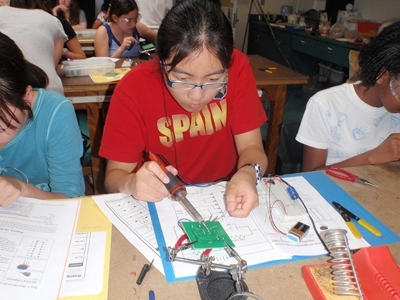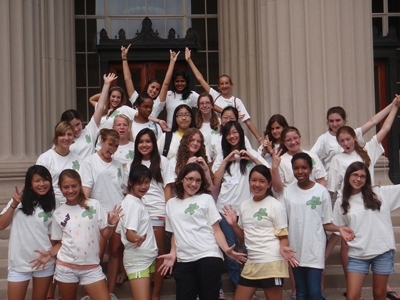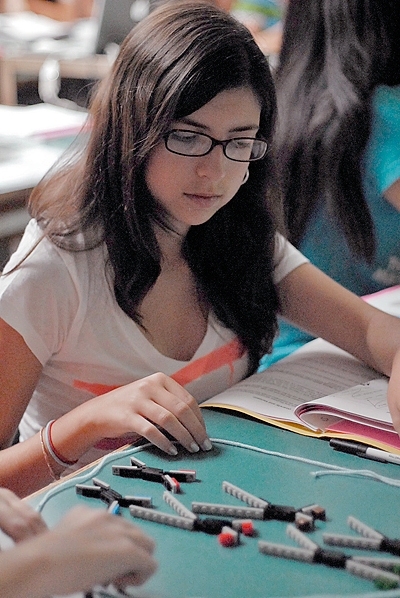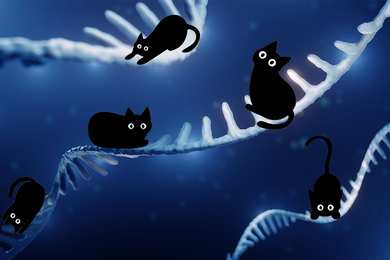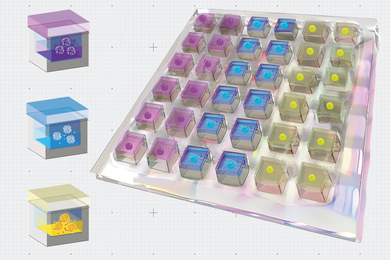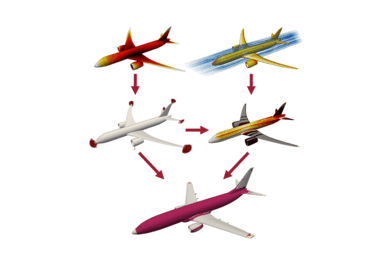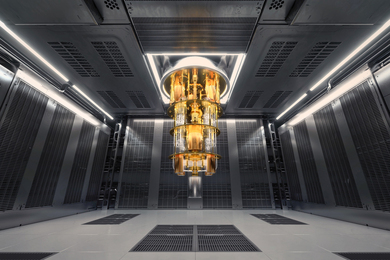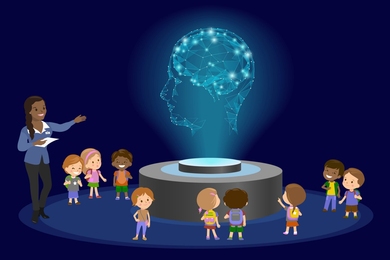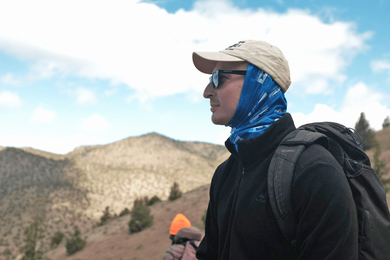For the 13th straight year, MIT was home to a special summer program aimed at expanding middle-school girls’ enthusiasm for science, technology and engineering. Sponsored by NASA’s “Summer of Innovation” and the MIT Edgerton Center, the program engaged 26 rising ninth-graders in a week of hands-on activities in mechanical engineering, biology, chemistry and electronics.
The program, called “You GO Girl!,” addresses a disturbing trend in American education. “The middle-school years are traditionally when girls begin to lose interest in science, or when peer pressure steers them away from the science fields,” said Edgerton Center Outreach Program Coordinator Amy Fitzgerald, who led the program with assistance from college-student aides. Fitzgerald hopes that the excitement of the hands-on opportunities in the program will encourage participants to continue with science, technology and engineering. Girls who took part in previous classes have told her “that the fun they had at You GO Girl! kept them going” in science, she said.
In one session this August, the students spent the morning proving how seemingly identical fish can produce babies with very different traits. Using LEGO bricks as genes and chromosomes, they modeled the steps of cell division and reproduction in LEGO fish. As they physically worked out dominant and recessive characteristics by altering their LEGO constructions, they understood how red-spotted fish can descend from blue-spotted parents. By producing multiple generations of LEGO fish, the girls also watched the population change over time in response to environmental pressures that selected for various traits. This engaging lesson was contributed by MIT’s Center for Environmental Health Sciences.
In the electronics segment, the girls assembled a small circuit board with capacitors, resistors, switches, and red, yellow and green LEDs to simulate a traffic light. They learned what the different components do, and read the symbols on circuit board maps. Everyone excitedly practiced soldering and wired up a printed circuit board that controls the LED lights. Fitzgerald and her college student aides circulated constantly among the students, asking questions and troubleshooting any problems. Huge grins bloomed across the girls’ faces when the lights blinked as intended.
Along with the science and engineering, the girls also spent scheduled time talking about this stage of their lives and the transition to high school. They learned what to expect from graduates of the program as well as the college student aides.
“The college students tell the girls about jobs they can get with a science degree, and what classes they should take in high school to be a science or engineering major,” Fitzgerald explained. “There are more jobs and opportunities out there than the girls know about. We take any chance we have to talk about the possibilities.”
What about the boys? The Edgerton Center, with funding from NASA’s Summer of Innovation, offered programs this summer to members of both genders, providing 118 students in grades six through 12 extensive hands-on experiences in engineering, science and technology.
For more information on You GO, Girl!, or other educational programs at the Edgerton Center, visit http://web.mit.edu/edgerton/outreach/.
For more information on NASA’s “Summer of Innovation," visit www.nasa.gov/soi.
The program, called “You GO Girl!,” addresses a disturbing trend in American education. “The middle-school years are traditionally when girls begin to lose interest in science, or when peer pressure steers them away from the science fields,” said Edgerton Center Outreach Program Coordinator Amy Fitzgerald, who led the program with assistance from college-student aides. Fitzgerald hopes that the excitement of the hands-on opportunities in the program will encourage participants to continue with science, technology and engineering. Girls who took part in previous classes have told her “that the fun they had at You GO Girl! kept them going” in science, she said.
In one session this August, the students spent the morning proving how seemingly identical fish can produce babies with very different traits. Using LEGO bricks as genes and chromosomes, they modeled the steps of cell division and reproduction in LEGO fish. As they physically worked out dominant and recessive characteristics by altering their LEGO constructions, they understood how red-spotted fish can descend from blue-spotted parents. By producing multiple generations of LEGO fish, the girls also watched the population change over time in response to environmental pressures that selected for various traits. This engaging lesson was contributed by MIT’s Center for Environmental Health Sciences.
In the electronics segment, the girls assembled a small circuit board with capacitors, resistors, switches, and red, yellow and green LEDs to simulate a traffic light. They learned what the different components do, and read the symbols on circuit board maps. Everyone excitedly practiced soldering and wired up a printed circuit board that controls the LED lights. Fitzgerald and her college student aides circulated constantly among the students, asking questions and troubleshooting any problems. Huge grins bloomed across the girls’ faces when the lights blinked as intended.
Along with the science and engineering, the girls also spent scheduled time talking about this stage of their lives and the transition to high school. They learned what to expect from graduates of the program as well as the college student aides.
“The college students tell the girls about jobs they can get with a science degree, and what classes they should take in high school to be a science or engineering major,” Fitzgerald explained. “There are more jobs and opportunities out there than the girls know about. We take any chance we have to talk about the possibilities.”
What about the boys? The Edgerton Center, with funding from NASA’s Summer of Innovation, offered programs this summer to members of both genders, providing 118 students in grades six through 12 extensive hands-on experiences in engineering, science and technology.
For more information on You GO, Girl!, or other educational programs at the Edgerton Center, visit http://web.mit.edu/edgerton/outreach/.
For more information on NASA’s “Summer of Innovation," visit www.nasa.gov/soi.
